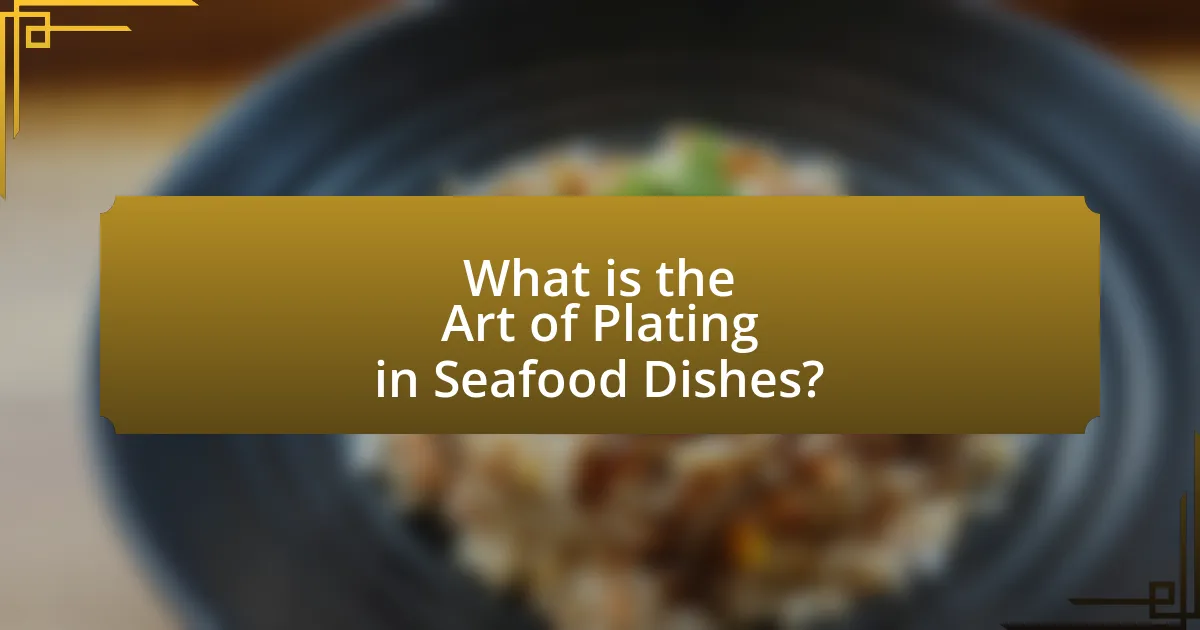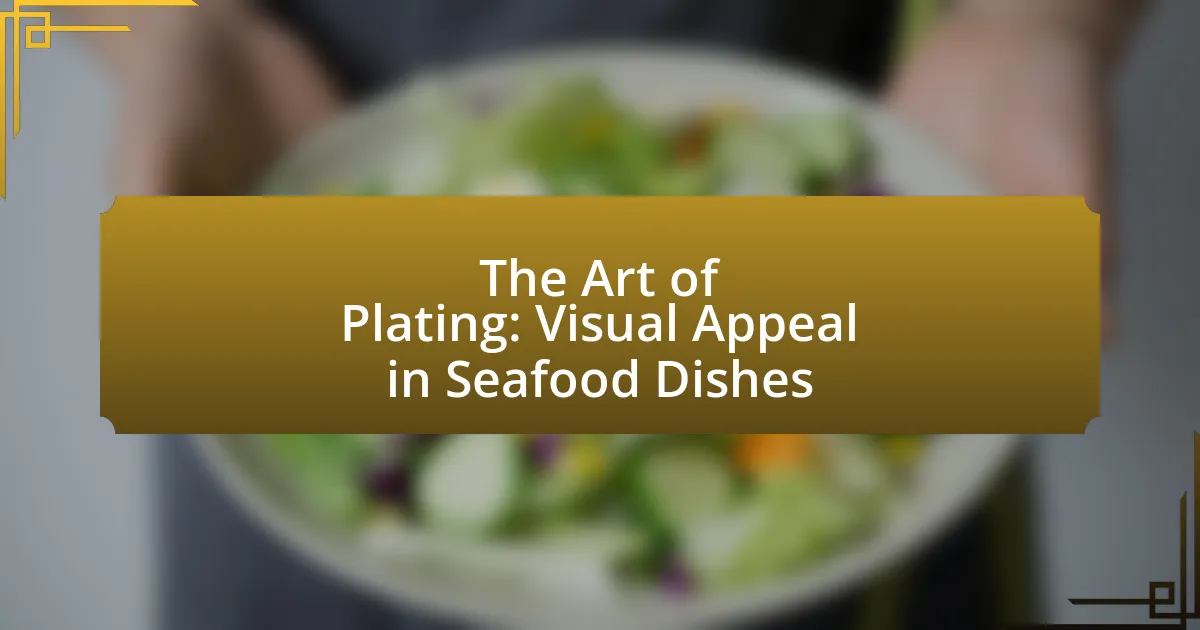The main entity of the article is the art of plating in seafood dishes, which focuses on the strategic arrangement of food to enhance visual appeal and elevate the dining experience. The article outlines key elements of effective plating, including color contrast, texture variety, portion size, and garnishing, all of which contribute to a dish’s aesthetic and perceived taste. It discusses the psychological effects of visual presentation on diners’ perceptions and enjoyment, emphasizing the importance of techniques such as layering and the use of garnishes. Additionally, the article highlights common mistakes to avoid in seafood plating and best practices for achieving balance and harmony in presentation.

What is the Art of Plating in Seafood Dishes?
The art of plating in seafood dishes involves the strategic arrangement of food on a plate to enhance visual appeal and elevate the dining experience. This technique emphasizes color contrast, texture variety, and the use of garnishes to create an inviting presentation. For instance, chefs often utilize vibrant ingredients like herbs or citrus to complement the natural hues of seafood, making the dish more visually striking. Studies in culinary arts highlight that well-plated dishes can significantly influence diners’ perceptions of taste and quality, reinforcing the importance of aesthetics in gastronomy.
How does plating enhance the visual appeal of seafood dishes?
Plating enhances the visual appeal of seafood dishes by creating an aesthetically pleasing presentation that engages the diner’s senses. Effective plating techniques, such as the use of color contrast, texture variation, and strategic arrangement, draw attention to the seafood, making it more enticing. Research indicates that visually appealing food can increase perceived taste and enjoyment, as demonstrated in studies where diners rated dishes higher when they were presented attractively. This connection between visual presentation and taste perception underscores the importance of plating in elevating the overall dining experience.
What are the key elements of effective plating in seafood cuisine?
The key elements of effective plating in seafood cuisine include color contrast, texture variety, portion size, and garnishing. Color contrast enhances visual appeal by using vibrant ingredients like herbs or citrus against the seafood, making the dish more inviting. Texture variety is important as it provides a sensory experience; combining crispy elements with tender seafood creates a balanced mouthfeel. Portion size should be appropriate to ensure the dish looks abundant yet refined, avoiding overcrowding on the plate. Finally, garnishing with fresh herbs or edible flowers not only adds aesthetic value but also complements the flavors of the seafood, enhancing the overall dining experience.
How does color contrast play a role in seafood plating?
Color contrast significantly enhances seafood plating by making dishes visually appealing and highlighting the freshness of the ingredients. High contrast between the seafood and its accompaniments, such as vibrant vegetables or garnishes, draws attention and creates an inviting presentation. For example, the bright orange of salmon against a bed of green herbs or a white plate emphasizes the dish’s colors, making it more appetizing. Studies in culinary arts indicate that color contrast can influence perception of flavor and freshness, with research showing that visually appealing plates can enhance the overall dining experience.
Why is visual appeal important in seafood presentation?
Visual appeal is important in seafood presentation because it significantly influences diners’ perceptions and enjoyment of the dish. A well-presented seafood dish can enhance the overall dining experience, making it more memorable and enticing. Research indicates that visually appealing food can increase appetite and perceived taste, as studies show that people often associate attractive presentation with higher quality and flavor. For instance, a study published in the journal “Appetite” found that food presentation affects taste perception, with participants rating visually appealing dishes as more flavorful. Thus, the aesthetic quality of seafood presentation plays a crucial role in attracting customers and enhancing their satisfaction.
How does visual appeal influence diners’ perceptions of taste?
Visual appeal significantly influences diners’ perceptions of taste by creating expectations that affect their overall dining experience. Research indicates that when food is presented attractively, diners are more likely to perceive it as tastier, even if the actual flavor remains unchanged. A study published in the journal “Appetite” by Spence et al. (2016) found that visual elements such as color, arrangement, and garnishing can enhance the perceived flavor and quality of a dish. This phenomenon occurs because the brain integrates visual information with sensory experiences, leading to a heightened enjoyment of the meal.
What psychological effects does plating have on seafood dishes?
Plating seafood dishes significantly influences diners’ psychological responses, enhancing their overall dining experience. The visual presentation of seafood can evoke emotions such as excitement and anticipation, which are crucial for enjoyment. Research indicates that aesthetically pleasing food can increase perceived taste and satisfaction; for instance, a study published in the journal “Appetite” found that visually appealing dishes can enhance flavor perception and increase the likelihood of positive dining experiences. Therefore, effective plating not only makes seafood more attractive but also positively impacts the psychological state of the consumer, leading to greater enjoyment and appreciation of the meal.

What techniques are commonly used in seafood plating?
Common techniques used in seafood plating include layering, garnishing, and using sauces to create visual contrast. Layering involves stacking or arranging seafood components in a way that adds height and dimension, enhancing the dish’s visual appeal. Garnishing with fresh herbs, edible flowers, or citrus slices adds color and freshness, making the dish more inviting. Additionally, drizzling sauces or purees around the seafood not only adds flavor but also creates a striking visual contrast, drawing attention to the main ingredients. These techniques are widely recognized in culinary arts for elevating the presentation of seafood dishes.
How can texture be incorporated into seafood plating?
Texture can be incorporated into seafood plating by using a variety of elements such as contrasting ingredients, garnishes, and cooking techniques. For instance, pairing a tender poached fish with crispy fried shallots or a crunchy vegetable slaw creates a pleasing contrast that enhances the overall dish. Additionally, incorporating elements like purees or foams can add a smooth texture that complements the seafood. Research indicates that visual texture can significantly influence the perception of taste, making it essential for chefs to consider both tactile and visual elements in plating.
What are some examples of textures that complement seafood dishes?
Crispy, creamy, and tender textures complement seafood dishes effectively. Crispy elements, such as fried shallots or tempura vegetables, provide a satisfying crunch that contrasts with the softness of fish or shellfish. Creamy textures, like avocado or a rich sauce, enhance the dish’s richness and balance the seafood’s natural flavors. Tender components, such as poached or steamed vegetables, add a delicate mouthfeel that harmonizes with the seafood’s texture. These combinations create a multi-dimensional eating experience, enhancing both flavor and visual appeal in seafood plating.
How does the arrangement of ingredients affect texture perception?
The arrangement of ingredients significantly influences texture perception by altering the way individuals experience and interpret the tactile qualities of food. When ingredients are strategically layered or grouped, they can create a contrast in textures that enhances the overall sensory experience; for example, pairing a creamy sauce with crunchy vegetables can heighten the perception of both textures. Research indicates that visual cues from the arrangement can prime the brain to expect certain textures, thereby affecting how they are perceived during consumption. A study published in the journal “Food Quality and Preference” by Spence et al. (2016) demonstrates that the visual presentation of food can modify texture perception, suggesting that aesthetic arrangements can lead to a more pronounced experience of texture.
What role does garnishing play in seafood plating?
Garnishing plays a crucial role in seafood plating by enhancing visual appeal and elevating the overall dining experience. Effective garnishes can complement the colors and textures of seafood, making the dish more inviting and appetizing. For instance, the use of fresh herbs like parsley or dill not only adds a pop of color but also contributes aromatic elements that enhance flavor perception. Studies in culinary arts emphasize that well-executed garnishing can increase perceived value and satisfaction among diners, as visually appealing dishes are often associated with higher quality and taste.
What types of garnishes work best with seafood dishes?
Citrus-based garnishes, such as lemon or lime wedges, work best with seafood dishes. These garnishes enhance the natural flavors of seafood by adding acidity and brightness, which can balance the richness of certain fish and shellfish. Additionally, fresh herbs like dill, parsley, or cilantro complement seafood by providing aromatic notes that elevate the dish’s overall presentation and taste. Studies in culinary arts emphasize that the visual appeal of garnishes, including vibrant colors and fresh ingredients, significantly enhances the dining experience, making seafood dishes more inviting and appetizing.
How can garnishes enhance the overall presentation of seafood?
Garnishes enhance the overall presentation of seafood by adding color, texture, and visual interest, which can elevate the dish’s appeal. For instance, vibrant herbs like parsley or dill can contrast beautifully with the natural hues of seafood, making the dish more visually striking. Additionally, garnishes such as lemon wedges or edible flowers can provide a fresh element that complements the flavors of the seafood, creating a more inviting plate. Research indicates that visually appealing dishes can increase perceived taste and enjoyment, highlighting the importance of garnishes in culinary presentation.

What are the common mistakes to avoid in seafood plating?
Common mistakes to avoid in seafood plating include overcrowding the plate, neglecting color contrast, and failing to consider the texture of the seafood. Overcrowding can make the dish appear chaotic and unappetizing, while a lack of color contrast can result in a visually dull presentation. Additionally, not highlighting the natural textures of seafood can diminish the overall appeal; for example, pairing a crispy element with a tender seafood piece enhances visual interest. These principles are supported by culinary experts who emphasize the importance of balance and aesthetics in plating to enhance the dining experience.
How can overloading a plate detract from seafood presentation?
Overloading a plate detracts from seafood presentation by obscuring the individual elements and diminishing visual appeal. When a plate is overcrowded, the distinct colors, textures, and shapes of the seafood are lost, making it difficult for diners to appreciate the dish’s artistry. Research in culinary presentation emphasizes that a well-composed plate allows for better visual contrast and highlights the freshness of ingredients, which is crucial in seafood dishes. For instance, a study published in the Journal of Culinary Science & Technology indicates that visual clarity enhances the perceived quality of food, suggesting that less is often more in plating.
What are the signs of cluttered plating in seafood dishes?
Cluttered plating in seafood dishes is characterized by an overwhelming number of elements on the plate, which can distract from the main seafood component. Signs include excessive garnishes that overshadow the seafood, overcrowding of different ingredients that create visual chaos, and a lack of negative space that makes the dish appear cramped. For instance, a well-plated seafood dish should highlight the fish or shellfish, allowing it to be the focal point, while too many sauces or sides can detract from its presentation.
How can simplicity improve the visual appeal of seafood dishes?
Simplicity enhances the visual appeal of seafood dishes by allowing the natural colors and textures of the ingredients to stand out. When seafood is presented with minimal embellishments, such as a clean plate and a few complementary garnishes, the focus shifts to the freshness and quality of the seafood itself. Research indicates that minimalist plating can evoke a sense of elegance and sophistication, making the dish more inviting. For instance, a study published in the Journal of Culinary Science & Technology highlights that diners perceive simpler presentations as more appetizing and high-quality, reinforcing the idea that simplicity in plating can significantly elevate the overall dining experience.
What are some best practices for plating seafood dishes?
Best practices for plating seafood dishes include using contrasting colors, arranging components thoughtfully, and incorporating garnishes that enhance flavor and presentation. Contrasting colors, such as vibrant greens or bright citrus, create visual interest against the often muted tones of seafood. Thoughtful arrangement involves placing the seafood as the focal point, with sides and sauces artfully positioned to complement it. Additionally, garnishes like fresh herbs or edible flowers not only add aesthetic appeal but also contribute to the overall flavor profile, making the dish more inviting. These practices are supported by culinary principles that emphasize the importance of visual appeal in enhancing the dining experience.
How can one achieve balance and harmony in seafood plating?
To achieve balance and harmony in seafood plating, one should focus on color, texture, and composition. Utilizing a variety of colors from the seafood and accompanying garnishes creates visual interest, while contrasting textures, such as crispy elements alongside tender seafood, enhances the overall experience. Additionally, arranging components in a way that guides the eye, such as using the rule of thirds, ensures a balanced presentation. Research indicates that visually appealing dishes can enhance perceived taste and enjoyment, supporting the importance of aesthetic considerations in culinary presentation.
What tips can enhance the overall presentation of seafood dishes?
To enhance the overall presentation of seafood dishes, focus on color contrast, plating techniques, and garnishing. Using vibrant ingredients like fresh herbs, citrus slices, or colorful vegetables can create visual appeal and highlight the seafood’s natural colors. Employing techniques such as stacking or layering can add height and dimension to the dish, making it more visually interesting. Additionally, garnishing with edible flowers or microgreens not only adds a pop of color but also elevates the dish’s sophistication. These methods are supported by culinary practices that emphasize the importance of visual aesthetics in food presentation, which can significantly influence diners’ perceptions and enjoyment.

Leave a Reply